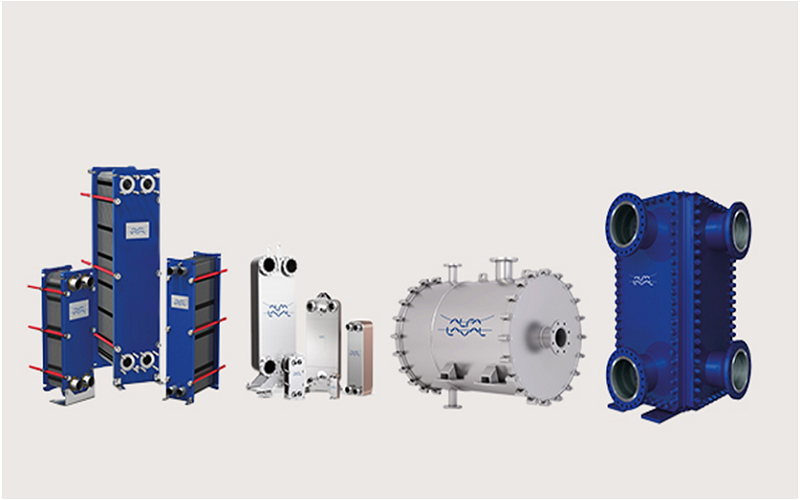Introduction
Heat exchangers form the backbone of countless applications, from chemical plants to power stations. Their ability to optimize energy usage and maintain temperature differentials is nothing short of remarkable. Let’s dive into the intricacies of these heat transfer wizards.
Heat Exchanger Basics
Aheat exchanger is a device that facilitates the transfer of thermal energy between two or more fluids. These fluids can be liquids, gases, or a combination of both. Heat exchangers find applications in diverse fields, including chemical processing, power generation, refrigeration, and HVAC systems. Imagine them as the diplomats of the thermal world, facilitating peaceful negotiations between hot and cold streams.
Types of Heat Exchangers
1. Shell-and-Tube Heat Exchangers
These exchangers are renowned for their versatility and durability. Within the cylindrical shell, multiple tubes provide ample surface area for heat exchange. Shell-and-tube exchangers are particularly suitable for high-pressure and high-temperature applications, making them indispensable in industries such as petrochemicals and refining. Despite their robustness, their bulky design may pose challenges in installations with space constraints, prompting engineers to explore more compact alternatives.
- Design: Consists of a cylindrical shell with tubes inside.
- Working Principle: One fluid flows through the tubes (the tube-side fluid), while the other flows around the tubes (the shell-side fluid).
- Advantages: Robust construction, suitable for high-pressure applications.
- Limitations: Bulky and less efficient for certain heat transfer scenarios.
2. Plate Heat Exchangers
Plate heat exchangers revolutionized the industry with their compact design and efficient heat transfer capabilities. The stacked arrangement of thin metal plates creates a labyrinth of flow channels, maximizing surface area and promoting turbulent flow for enhanced heat exchange. These exchangers excel in applications where space is limited, such as marine and automotive industries. However, their susceptibility to fouling necessitates periodic maintenance to sustain optimal performance.
- Design: Comprises a stack of thin metal plates with alternating channels.
- Working Principle: Fluids flow through separate channels, allowing efficient heat transfer due to large surface area.
- Advantages: Compact, lightweight, and excellent heat transfer performance.
- Limitations: Susceptible to fouling in some cases.
3. Compact Plate Heat Exchangers (CPHEs)
Compact heat exchangers represent the pinnacle of efficiency and space-saving design. By incorporating closely spaced plates with intricate patterns, Compact heat exchangers (CPHEs) achieve remarkable heat transfer performance while minimizing footprint. Their versatility extends to various applications, including HVAC systems, refrigeration, and food processing. The intricate plate patterns optimize fluid flow, reducing pressure drop and enhancing thermal efficiency. Moreover, their modular construction facilitates scalability, enabling seamless integration into diverse industrial processes.
- Special Focus: Compact plate heat exchangers (CPHEs) are a subset of plate heat exchangers.
- Design: Utilize closely spaced plates with intricate patterns.
- Applications: Widely used in HVAC systems, refrigeration, and industrial processes.
- Advantages: High efficiency, space-saving design, and easy maintenance.
4. Other Variants:
Beyond the discussed types, the realm of heat exchangers encompasses a plethora of specialized variants catering to specific requirements. These may include welded plate heat exchangers, gasketed plate-and-frame exchangers, and spiral heat exchangers, among others. Each variant offers unique features and advantages tailored to distinct operating conditions and fluid properties. Engineers meticulously select the most suitable exchanger type based on factors such as thermal performance, space constraints, maintenance requirements, and lifecycle costs.
Key Considerations
When selecting a heat exchanger, engineers must weigh several factors:
- Fluid Compatibility: Ensure that the materials used in the exchanger are compatible with the fluids being processed.
- Pressure Drop: Evaluate the pressure loss across the exchanger to optimize system performance.
- Fouling Tendencies: Consider the likelihood of fouling (deposition of unwanted substances) and choose an exchanger accordingly.
- Thermal Performance: Assess the exchanger’s ability to transfer heat efficiently.
The choice between shell-and-tube and plate heat exchangers depends on the specific application requirements.
Remember, whether it’s a compact plate heat exchanger or a traditional shell-and-tube design, understanding the fundamentals ensures successful heat transfer in industrial systems.
Heat Exchangers in the Mining Industry
Heat exchangers are integral to the mining industry, playing a crucial role in various applications:
- Cooling and Heating: Heat exchangers help in cooling down machinery and heating substances, ensuring optimal operating conditions and safety.
- Types of Heat Exchangers: The mining industry commonly uses shell and tube, plate, and finned heat exchangers. Each type has its unique advantages and is suited for specific applications.
- Efficiency: Heat exchangers contribute to the overall efficiency of mining operations by reducing energy consumption and recovering waste heat.
- Sustainability: By reusing waste heat, heat exchangers contribute to sustainable mining practices, reducing the industry’s environmental impact.
Conclusion
In conclusion, the evolution of heat exchangers continues to drive advancements in efficiency and sustainability across various industries. As technology progresses, we witness innovations that further enhance the performance and versatility of these vital components. From the robustness of shell-and-tube heat exchangers to the compact efficiency of plate and compact plate heat exchangers, each design offers unique advantages tailored to specific applications.
Looking ahead, the future of heat exchangers holds promise for even greater efficiency, reliability, and adaptability. Continued research and development efforts are poised to uncover novel materials, designs, and manufacturing techniques that will further revolutionize heat transfer processes. By staying abreast of these advancements and leveraging the versatility of heat exchangers, engineers and industries can continue to push the boundaries of energy conservation, process optimization, and sustainable practices, ushering in a new era of thermal management excellence.





